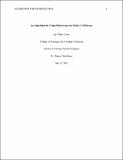An Algorithm for Using Hydroxyurea in Sickle Cell Disease
Author
Curry, Joy
Abstract
Sickle Cell Disease (SCD) is an inherited blood disorder that affects many African Americans globally. This disease is characterized by acute complications from chronic anemia, episodes of painful acute on chronic vaso-occlusive pain syndrome, and organ damage. Despite optimizing Hydroxyurea (HU), these events can still occur. The purpose of the DNP project was to implement an algorithm to standardize HU for specific genotypes, particularly hemoglobin SS and hemoglobin Sβ-0-thalassemia. The project aimed to increase HU prescribing and improve educational opportunities for this disease-modifying therapy to achieve the benchmark of at least 80% prescribing. The Plan-Do-Study-Act methodology was used to test change and evaluate HU prescribing. Findings from the project indicated an increase in prescribing with the use of the algorithm. The algorithm provided an evidence-based guideline for decision-making based on eligible hemoglobinopathies. Standardizing this algorithm enabled providers to increase HU prescribing and provide educational leaflets on HU to patients which, in turn, increased the interests of the participants to engage in self-management. HU is an effective way of improving the patients’ outcomes for preventing complications with SCD.
Date
2021-07-26
Citation:
APA:
Curry, Joy.
(July 2021).
An Algorithm for Using Hydroxyurea in Sickle Cell Disease
(DNP Scholarly Project, East Carolina University). Retrieved from the Scholarship.
(http://hdl.handle.net/10342/9293.)
MLA:
Curry, Joy.
An Algorithm for Using Hydroxyurea in Sickle Cell Disease.
DNP Scholarly Project. East Carolina University,
July 2021. The Scholarship.
http://hdl.handle.net/10342/9293.
June 29, 2024.
Chicago:
Curry, Joy,
“An Algorithm for Using Hydroxyurea in Sickle Cell Disease”
(DNP Scholarly Project., East Carolina University,
July 2021).
AMA:
Curry, Joy.
An Algorithm for Using Hydroxyurea in Sickle Cell Disease
[DNP Scholarly Project]. Greenville, NC: East Carolina University;
July 2021.
Collections

